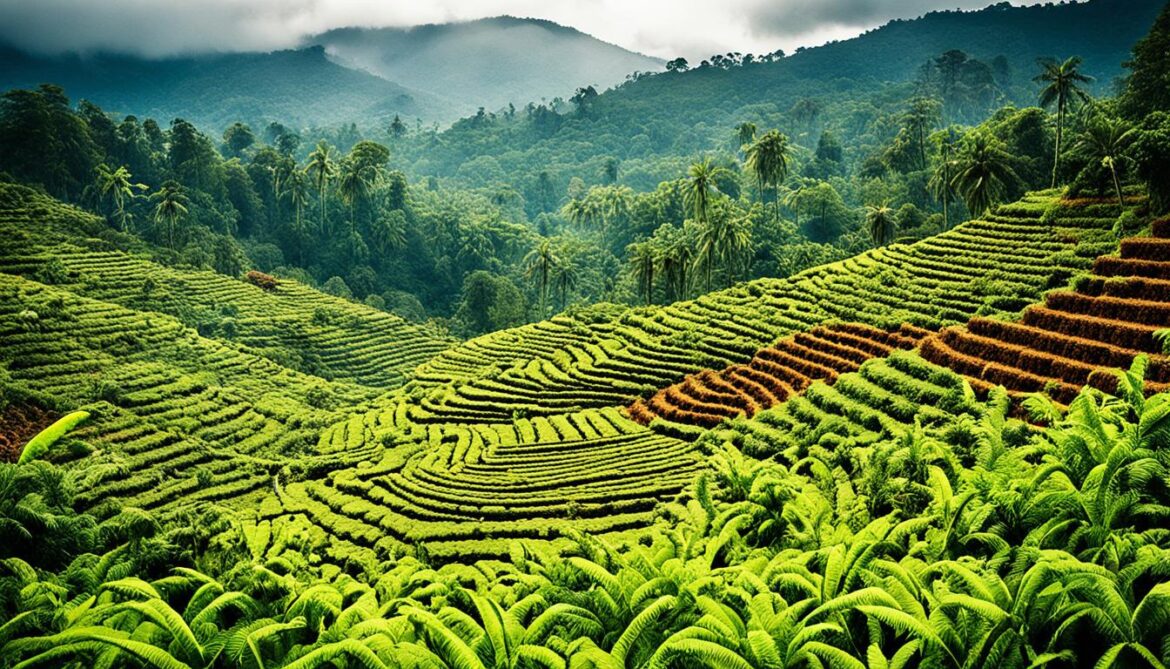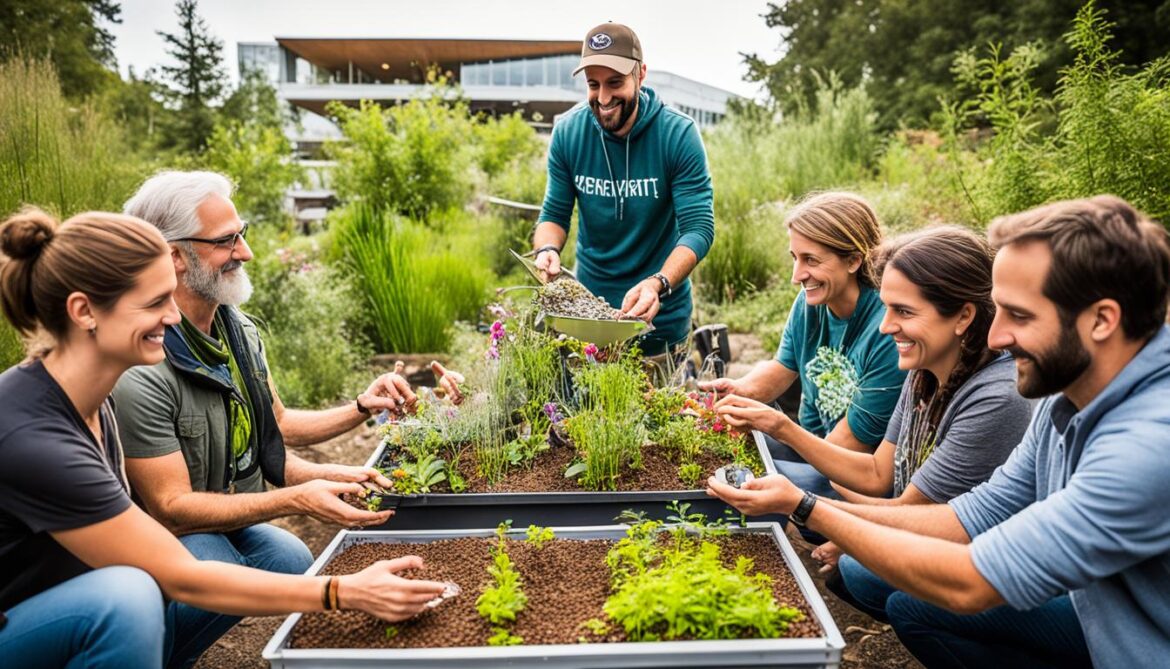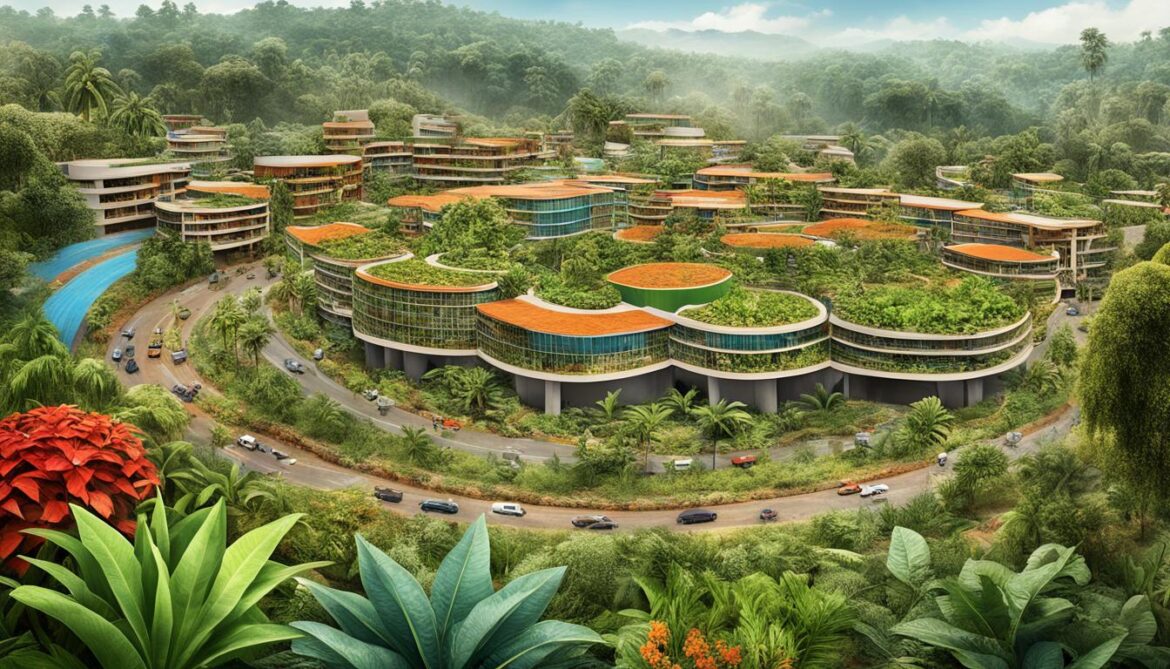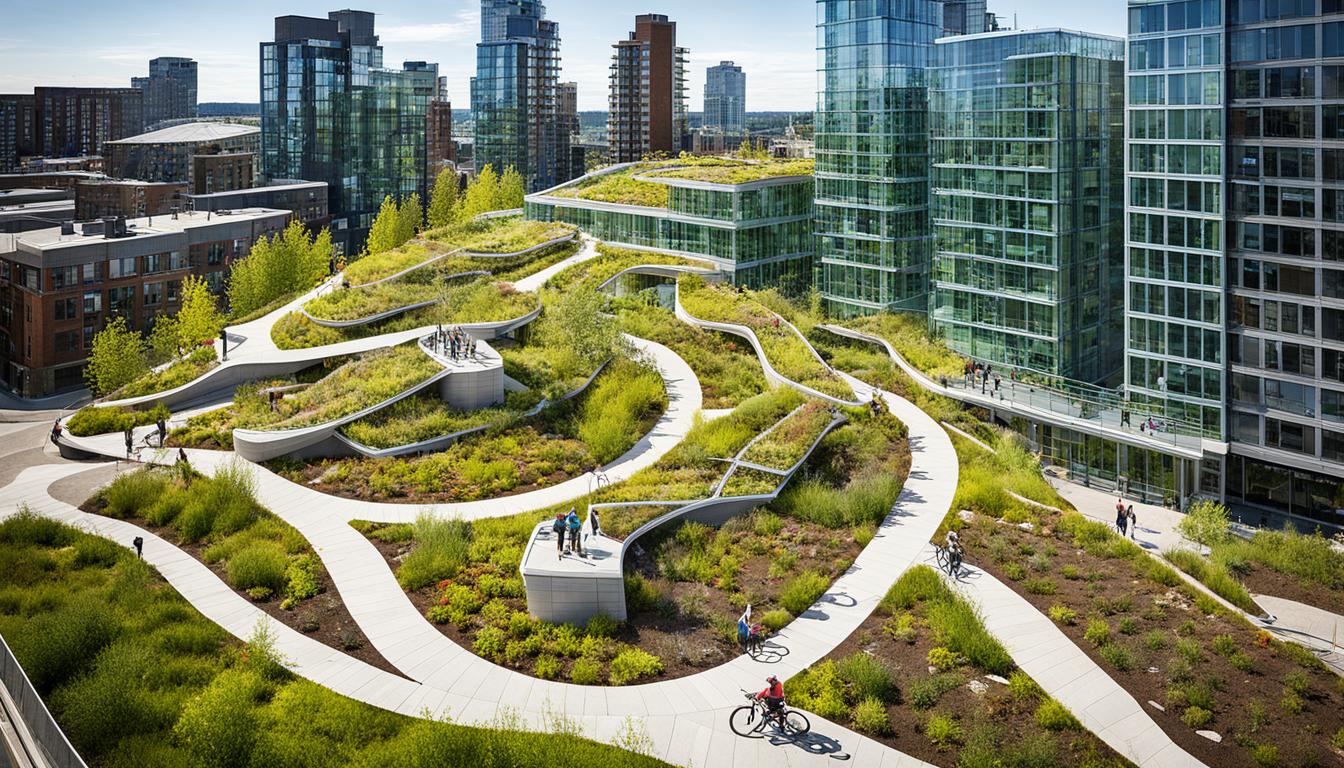Cameroon Biodiversity and the Built Environment
Cameroon, located in West Africa, is renowned for its exceptional beauty and diverse range of ecosystems, encompassing rainforests, mountains, and savannahs. This country is home to a wealth of biodiversity, boasting over 900 species of birds and 300 species of mammals. However, the delicate balance of Cameroon’s biodiversity is under threat due to the exploitation of natural resources and the ecological impact of climate change.
To combat these challenges, Cameroon is dedicated to the conservation and sustainable development of its precious biodiversity. Through effective urban planning, wildlife preservation, and habitat management, the country is striving to maintain its ecological equilibrium and promote environmental sustainability. Furthermore, Cameroon recognizes the importance of responsible natural resources management for the well-being of both its population and the surrounding environment.
Key Takeaways:
- Conservation and sustainable development are crucial for safeguarding Cameroon’s unique biodiversity.
- Urban planning plays a vital role in preserving wildlife and managing habitats in the built environment.
- The environmental impact of climate change poses a significant threat to Cameroon’s biodiversity.
- Efficient management of natural resources is essential for the long-term sustainability of both the population and the ecosystem.
- Cameroon is committed to engaging in responsible practices to ensure the preservation of its remarkable biodiversity.
Climate Change and its Impact on Biodiversity
Climate change and climate variation have a profound impact on ecosystems, disrupting the delicate balance of nature and posing significant challenges to biodiversity conservation. The negative effects of climate change, such as rising temperatures, altered rainfall patterns, and increased frequency of extreme weather events, directly affect the well-being of ecosystems and the species that inhabit them.
To mitigate these impacts, Cameroon is implementing ecosystem-based adaptation measures to reduce the vulnerability of ecosystems and enhance their resilience to climate change. These measures involve the implementation of sustainable agricultural and livestock practices, which promote biodiversity conservation while ensuring food security and livelihoods for local communities.
Integrated freshwater catchment management is another crucial aspect of climate change adaptation in Cameroon. By effectively managing freshwater resources, such as rivers, lakes, and wetlands, the country can mitigate the negative impacts of climate change on freshwater ecosystems and the numerous species that rely on them.
Afforestation and reforestation programs play a vital role in climate change adaptation and biodiversity conservation. By restoring degraded forests and establishing new forested areas, Cameroon aims to enhance carbon sequestration, conserve habitats for diverse wildlife species, and protect watersheds.
“Sustainable forest management is a powerful tool in combatting climate change and preserving biodiversity. It allows us to restore degraded ecosystems, protect threatened species, and promote the sustainable use of forest resources.” – John Ombogo, Conservationist
The creation of protected areas and the restoration of degraded ecosystems are integral components of Cameroon’s strategy to safeguard biodiversity in the face of climate change. Protected areas act as sanctuaries for endangered species and provide crucial habitats for a wide range of plant and animal species. The restoration of degraded ecosystems allows for the recovery of biodiversity and the reestablishment of ecosystem services.
| Climate Change Impacts on Biodiversity | Ecosystem-based Adaptation Measures |
|---|---|
| Loss of habitat and biodiversity | Establishment of protected areas and restoration of degraded ecosystems |
| Species range shifts and extinctions | Sustainable agricultural and livestock practices |
| Disruption of ecological processes | Integrated freshwater catchment management |
| Increased vulnerability of ecosystems | Afforestation and reforestation programs |
Ecosystem-based Adaptation Measures:
- Sustainable agricultural and livestock practices
- Integrated freshwater catchment management
- Afforestation and reforestation programs
Benefits of Climate Change Adaptation:
- Preservation of biodiversity and ecosystem services
- Enhanced resilience to the impacts of climate change
- Sustainable livelihoods for local communities
Effective Protected Area Management in Cameroon
Protected areas play a crucial role in conserving biodiversity and maintaining the health of ecosystems. In Cameroon, these protected areas cover approximately 20% of the country’s land area, exceeding the global target of 30%. However, the challenge lies in ensuring the effective management of these areas to maximize their conservation impact and sustain the benefits they provide.
Funding and human resource constraints often hinder the proper management of protected areas in Cameroon. With limited financial resources and personnel, it becomes challenging to carry out essential conservation activities, such as monitoring and enforcement. To address this challenge, it is crucial to explore innovative funding mechanisms and partnerships that can provide the necessary resources for effective management.
Another vital aspect of protected area management is the involvement of indigenous and local communities. These communities have a deep understanding of their local ecosystems and have been stewards of the land for generations. By including them in the decision-making processes and management of protected areas, their traditional knowledge and practices can contribute significantly to the conservation efforts.
“Indigenous and local communities are key stakeholders in protecting and managing biodiversity. Their participation ensures the inclusivity and long-term sustainability of conservation efforts.”
Cameroon recognizes the importance of increasing the coverage of protected areas to ensure the representation of all ecosystems and improve the status of threatened species. This expansion will enhance the overall ecosystem representativeness and contribute to the preservation of biodiversity.
Sustainable management of protected areas is essential to maintain their ecological integrity and conserve the biodiversity they harbor. This involves implementing practices and strategies that minimize human impacts while allowing for the sustainable use of natural resources. Through sustainable management, both the needs of biodiversity and the socio-economic needs of local communities can be balanced.
In addition to sustainable management, there is a need to valorize biodiversity within protected areas. By recognizing the economic value of biodiversity and ecosystem services, local communities can benefit from their sustainable utilization. Access and benefit sharing schemes can ensure that communities receive fair compensation for their stewardship efforts and that the economic benefits derived from biodiversity are shared equitably.
Ensuring effective management of protected areas in Cameroon requires continuous collaboration and coordination among stakeholders, including government agencies, NGOs, local communities, and the private sector. By working together, these stakeholders can develop and implement strategies that promote the conservation of biodiversity while benefiting local communities and fostering sustainable development.
Challenges and Solutions in Protected Area Management
| Challenges | Solutions |
|---|---|
| Funding and human resource constraints | Innovative funding mechanisms and partnerships Capacity building and training programs Engagement of local communities and stakeholders |
| Inadequate representation of ecosystems and threatened species | Expansion of protected areas Identification and designation of new reserves and conservation areas |
| Lack of sustainable management practices | Implementation of sustainable land-use practices and resource management Enforcement of regulations and monitoring programs |
| Limited benefit-sharing mechanisms | Development of access and benefit sharing schemes Economic valuation of biodiversity and ecosystem services |
| Poor coordination and collaboration | Establishment of multi-stakeholder platforms Enhancement of coordination mechanisms and information sharing |
Effective protected area management in Cameroon is crucial for the conservation of biodiversity, the well-being of local communities, and the sustainable development of the country. By addressing the challenges and implementing the solutions outlined above, Cameroon can ensure the long-term preservation of its natural heritage and contribute to global efforts in biodiversity conservation.

Conserving Genetic Diversity in Agricultural Practices
The dominance of a few cultivated species in global food consumption poses a threat to the genetic diversity of indigenous and local cultivated plants, domesticated animals, and their wild relatives. Conventional and industrial agricultural practices, including the use of genetically modified organisms, further endanger these species.
Cameroon is committed to maintaining and valorizing the genetic diversity of cultivated plants, domesticated animals, and their threatened wild relatives. This involves identifying threatened species, developing management programs, and promoting the commercialization of genetic resources with economic potential.
The Importance of Genetic Diversity
Genetic diversity is vital for the long-term sustainability of agriculture and the preservation of biodiversity. It enables plants and animals to adapt to changing environmental conditions, resist diseases and pests, and enhance overall resilience.
By conserving genetic diversity, farmers and researchers can access a wide range of traits and characteristics that can be utilized to improve crop productivity, nutritional quality, and the adaptability of livestock to different environments.
Genetic diversity also plays a crucial role in ensuring sustainable agriculture. It provides a buffer against the risks posed by climate change, such as extreme weather events and shifting pest and disease patterns.
Threats to Genetic Diversity
The commercialization of agriculture and the focus on a limited number of high-yielding crops and livestock breeds have led to the neglect of many locally adapted varieties and breeds. This has resulted in the loss of unique and valuable genetic resources.
Furthermore, the use of genetically modified organisms (GMOs) in agriculture has raised concerns about the potential for genetic pollution and the displacement of traditional varieties and breeds. The unintentional mixing of GMOs with native varieties can lead to a loss of genetic purity and the homogenization of agriculture.
Conservation Strategies
Cameroon recognizes the need to conserve genetic diversity in agricultural practices to ensure sustainable and resilient food production systems. The country has implemented several strategies to achieve this:
- Identifying threatened species: Conducting comprehensive surveys and assessments to identify cultivated plants, domesticated animals, and their wild relatives that are at risk of genetic erosion.
- Developing management programs: Implementing conservation programs, such as seed banks, gene banks, and breeding programs, to safeguard and restore genetic diversity in crops and livestock.
- Promoting commercialization: Encouraging the sustainable and responsible commercialization of genetic resources, creating opportunities for farmers and local communities to benefit economically.
Through these efforts, Cameroon aims to preserve the genetic diversity of its cultivated plants, domesticated animals, and threatened wild relatives, ensuring the long-term sustainability of agriculture and the conservation of valuable genetic resources.
Engaging Communities in Biodiversity Conservation
The conservation and sustainable use of biological resources heavily rely on the active involvement of indigenous and local communities. Unfortunately, the erosion of cultural values supporting biodiversity preservation is a result of their limited participation in conservation programs. To address this, Cameroon is dedicated to promoting community-based conservation and ecosystem management approaches that integrate customary norms and traditional knowledge into biodiversity management.
“Indigenous and local communities play a vital role in the preservation of our natural heritage. Their knowledge and practices have sustained the delicate balance of our ecosystems for generations. It is paramount that we empower these communities to actively engage in biodiversity conservation.”
Cameroon’s approach includes the establishment of community-based conservation programs that empower local communities to actively protect and manage their surrounding ecosystems. By integrating biodiversity conservation into community forest management plans, Cameroon aims to ensure that customary norms and traditional knowledge are incorporated into decision-making processes. Moreover, the rehabilitation of sacred forests serves as a powerful symbol of the importance of protecting biodiversity within cultural landscapes.
Benefits of Engaging Communities in Biodiversity Conservation
The active involvement of indigenous and local communities in biodiversity conservation offers a range of benefits:
- Promotes community ownership and responsibility for conservation efforts
- Preserves traditional practices, knowledge, and cultural heritage
- Enhances sustainability by aligning conservation with local livelihoods
- Strengthens social cohesion and community resilience
- Fosters long-term commitment and stewardship towards biodiversity
By engaging communities, Cameroon aims to create a sense of shared responsibility and empower individuals with valuable traditional knowledge and practices. This collaborative approach strengthens the foundation for effective biodiversity conservation and ecosystem management.

Image: Community-based conservation initiatives empower local communities to actively participate in biodiversity preservation.
| Traditional | Community-based Conservation |
|---|---|
| Reliant on external interventions | Driven by local communities with external support |
| Exclusionary practices | Inclusive decision-making processes |
| Disconnect between conservation efforts and cultural values | Aligned with traditional norms and knowledge |
| Loss of biodiversity’s cultural significance | Preservation of cultural heritage intertwined with biodiversity conservation |
Comparison of traditional conservation methods and community-based conservation.
Engaging communities allows for the integration of diverse perspectives, ensuring a holistic approach to biodiversity conservation and ecosystem management. By fostering partnerships and respecting customary norms, Cameroon is nurturing the invaluable relationship between people and nature, thereby safeguarding its unique biological heritage for generations to come.
Economic Valuation of Biodiversity
The economic valuation of biodiversity and ecosystem services plays a vital role in understanding the potential economic benefits that can be derived from the conservation and sustainable utilization of Cameroon’s diverse ecosystems. Unfortunately, this practice is still in its infancy in the country. Recognizing the importance of biodiversity valuation, Cameroon is committed to developing and implementing a comprehensive program to assess the economic potentials of its natural resources.
As part of this program, Cameroon aims to enhance capacities in economic planning and biodiversity accounting. By equipping professionals with the necessary skills and knowledge, the country can effectively evaluate the monetary value of its biodiversity, taking into account factors such as genetic resources and carbon stocks. The availability of accurate economic data will create a solid foundation for evidence-based decision-making and policy development.
In addition to valuation, Cameroon recognizes the need to promote the commercialization of the country’s biological and genetic resources. By fostering sustainable business models and entrepreneurship, the economic potentials of biodiversity can be harnessed to support local communities and drive economic growth. This includes encouraging responsible practices in industries such as pharmaceuticals, cosmetics, and agriculture, where genetic resources play a crucial role.
Furthermore, Cameroon understands the significance of payment for ecosystem services (PES) as a means to incentivize the sustainable management of natural resources. By establishing mechanisms for PES, including carbon stocks, the country can generate increased revenue to fund biodiversity conservation efforts and promote the sustainable utilization of ecosystems. These payments can provide economic incentives for local communities and other stakeholders to engage in conservation practices, ensuring the long-term viability of Cameroon’s unique biodiversity.

Biodiversity Valuation: Key Components
| Component | Description |
|---|---|
| Economic Planning | Enhancing capacity in economic planning to integrate biodiversity valuation into development strategies and decision-making processes. |
| Biodiversity Accounting | Developing systems to measure and monitor biodiversity resources, their distribution, and the economic value they generate. |
| Commercialization of Genetic Resources | Promoting responsible commercialization of biological and genetic resources to stimulate economic growth and benefit local communities. |
| Payment for Ecosystem Services | Establishing mechanisms for payments, including carbon stocks, to incentivize sustainable management and conservation of ecosystems. |
Economic valuation of biodiversity enables Cameroon to fully appreciate the importance of its natural assets, fostering a deeper understanding of the economic benefits derived from ecosystem services. By integrating biodiversity valuation into its economic planning and decision-making processes, Cameroon is taking a significant step towards achieving sustainable development while safeguarding its precious biodiversity for future generations.
Sharing Benefits from Sustainable Utilization of Biodiversity
Currently, the utilization of biological and genetic resources in Cameroon faces a significant challenge when it comes to equitable sharing of benefits. Local communities, especially indigenous communities, often do not receive their fair share of the economic benefits derived from these resources. Additionally, the traditional knowledge of these communities, which plays a crucial role in biodiversity conservation, is often undervalued and underutilized.
Cameroon recognizes the need to address this issue and is committed to developing and implementing mechanisms that promote payments and benefits sharing to improve the livelihoods of local communities. These mechanisms will be guided by comprehensive benefit-sharing frameworks, regulations, and guidelines that ensure the fair and sustainable utilization of biological resources.
“Equitable sharing of benefits is essential to incentivize the conservation and sustainable use of biodiversity. It’s not just about protecting ecosystems; it’s also about supporting the communities that have traditionally stewarded these resources.”
The focus of these efforts extends beyond forests, encompassing a wide range of ecosystems and genetic resources. By expanding compensation schemes to cover various sectors, including agriculture, medicinal plants, and other commercial activities, Cameroon aims to create a more inclusive and balanced system of benefits sharing.
Furthermore, the protection of traditional knowledge held by indigenous and local communities is a key aspect of these initiatives. Cameroon recognizes that traditional knowledge plays a vital role in biodiversity conservation and sustainable resource management. Therefore, efforts will be made to protect and promote the traditional knowledge systems of these communities.
Enhancing Community Capacity
An integral part of achieving equitable benefits sharing is building the capacity of indigenous and local communities to participate in biodiversity-related compensation schemes. This involves providing access to training, resources, and tools that enable community members to actively engage in the decision-making processes and management of biodiversity resources.
“By investing in the capacity building of indigenous and local communities, we empower them to actively participate in the sustainable utilization of biodiversity and ensure their voices are heard in conservation efforts.”
Through targeted capacity-building programs, Cameroon aims to equip these communities with the skills and knowledge needed to engage in commercial activities, negotiate fair agreements, and effectively manage their resources. By strengthening community capacity, Cameroon aims to create a more inclusive and sustainable approach to biodiversity conservation and utilization.

In conclusion, Cameroon recognizes the importance of sharing benefits from the sustainable utilization of biodiversity. By developing comprehensive mechanisms for payments and benefits sharing, expanding compensation schemes, protecting traditional knowledge, and building community capacity, Cameroon aims to create a more equitable and sustainable future for local communities and biodiversity.
Enhancing Biodiversity Coordination
Cameroon is dedicated to improving biodiversity coordination through various mechanisms to enhance the effectiveness of biodiversity-related activities by 2020. The country recognizes the importance of developing sectoral and regional plans, capacity building, and gender mainstreaming to achieve successful implementation.
To improve coordination and collaboration, Cameroon aims to establish robust coordination mechanisms that bring together stakeholders from different sectors involved in biodiversity conservation and sustainable development.
“Effective coordination is crucial for achieving our biodiversity conservation goals. By working together, we can maximize our efforts and ensure the protection and sustainable utilization of our natural resources.”
One key aspect of enhancing biodiversity coordination is the development of sectoral and regional plans that align with biodiversity conservation objectives. These plans will provide a roadmap for integrating biodiversity considerations into various sectors, such as agriculture, forestry, and tourism.
Capacity building plays a vital role in strengthening the expertise and knowledge of key actors involved in biodiversity conservation. By equipping individuals and organizations with the necessary skills and resources, Cameroon aims to enhance their ability to effectively implement biodiversity initiatives and manage conservation areas.
Gender mainstreaming is also a priority in biodiversity coordination efforts. It involves ensuring equal participation and representation of both genders in decision-making processes and incorporating gender perspectives into conservation policies and programs.
Benefits of Enhanced Biodiversity Coordination
Enhancing biodiversity coordination in Cameroon will lead to numerous benefits, including:
- Improved collaboration and information-sharing among stakeholders
- Enhanced effective implementation of biodiversity conservation measures
- Greater alignment of sectoral and regional plans with biodiversity objectives
- Increased capacity to address biodiversity threats and challenges
- Promotion of gender equality and inclusivity in conservation initiatives

By prioritizing biodiversity coordination, Cameroon is taking a significant step towards safeguarding its rich natural heritage and contributing to global conservation efforts.
Strategic Development and Capacity Building
By 2020, key production sectors and decentralised local authorities in Cameroon are expected to develop sector or regional plans that integrate biodiversity conservation and sustainable development. This includes capacity building for key actors, gender mainstreaming, and the inclusion of biodiversity considerations in development planning processes. The aim is to ensure that biodiversity conservation is integrated into key sectors and local governance structures for sustainable development.
The strategic development of Cameroon’s key production sectors is essential for promoting sustainable practices that protect biodiversity and ensure the long-term well-being of both the environment and the population. By integrating biodiversity conservation into sectoral and regional plans, Cameroon can harness the economic potential of key industries while safeguarding its natural resources.

Capacity building plays a crucial role in this process, empowering key actors with the knowledge and skills needed to implement sustainable practices and effectively manage biodiversity. Through training programs, workshops, and knowledge sharing initiatives, Cameroon can equip its workforce with the tools necessary to make informed decisions that prioritize environmental conservation.
Gender mainstreaming is another critical aspect of Cameroon’s strategic development and capacity building efforts. By ensuring the active participation and representation of women in biodiversity conservation and sustainable development, Cameroon can tap into the valuable perspectives, expertise, and contributions of its female population. Gender-responsive policies and initiatives can help address gender inequalities, promote inclusivity, and achieve more sustainable and equitable outcomes.
“The integration of biodiversity considerations into development planning processes is vital for achieving a balance between economic development and environmental preservation. Through strategic development and capacity building, Cameroon is taking significant steps towards securing a sustainable future for its key production sectors and local communities.”
Economic Sectors and Biodiversity Conservation:
To illustrate the integration of biodiversity conservation into key sectors, let’s take a closer look at two prominent industries in Cameroon:
| Economic Sector | Integration of Biodiversity Conservation |
|---|---|
| Agriculture | Promoting sustainable agricultural practices, such as agroforestry and organic farming, to minimize negative environmental impacts and conserve biodiversity. Implementing measures to protect natural pollinators and preserve genetic diversity of crops. |
| Tourism | Developing ecotourism initiatives that prioritize responsible wildlife viewing, support local communities, and contribute to the conservation of fragile ecosystems. Establishing guidelines for sustainable tourism practices and promoting awareness among tourists. |
By incorporating biodiversity conservation principles into these and other key sectors, Cameroon can strike a balance between economic growth and environmental sustainability. This integrated approach will benefit local communities, biodiversity, and the overall resilience of the country.
Through strategic development and capacity building, Cameroon is leading the way in demonstrating that sustainable development and biodiversity conservation go hand in hand. By empowering key actors, promoting gender mainstreaming, and integrating biodiversity considerations into sectoral and regional plans, Cameroon is laying the groundwork for a future where economic prosperity and environmental stewardship coexist.
Conclusion
Cameroon’s commitment to conserving its biodiversity while promoting sustainable urban development and habitat management in the built environment is vital to safeguarding its diverse ecosystems. Through the implementation of comprehensive strategies and actions, Cameroon strives to address the threats posed by climate change, protect valuable ecosystems and biodiversity, engage local communities, and ensure the sustainable utilization of natural resources. These efforts are essential for the well-being and prosperity of both the population and the environment in Cameroon.
With its abundant natural resources and unique ecosystems, Cameroon faces challenges such as habitat destruction, species extinction, and the impacts of climate change. However, by focusing on conservation and sustainable development, Cameroon can foster a harmonious relationship between nature and human activities, promoting the preservation of its rich biodiversity for future generations.
By integrating conservation measures into urban planning, adopting sustainable agricultural practices, enhancing protected area management, conserving genetic diversity in agriculture, empowering local communities, valuing biodiversity economically, and ensuring equitable sharing of benefits, Cameroon is moving towards a more environmentally sustainable and resilient future. These efforts reflect the country’s determination to address biodiversity threats and climate change impacts holistically, promoting a balanced coexistence between humans and nature.
FAQ
What is the impact of climate change on biodiversity in Cameroon?
Climate change has negative impacts on ecosystems in Cameroon, which in turn affect the well-being of the population dependent on these ecosystems. The country is implementing ecosystem-based climate change adaptation measures such as sustainable agricultural practices, freshwater catchment management, and afforestation/reforestation programs to reduce the negative effects of climate change and enhance resilience to its impacts.
How are protected areas managed in Cameroon?
Currently, protected areas cover around 20% of the land area in Cameroon, which is beyond the global target of 30%. However, effective management of these protected areas is hindered by funding and human resource constraints. There is a need to involve indigenous and local communities in decision-making processes and management. Cameroon aims to increase the coverage of protected areas to ensure the representation of all ecosystems and improve the status of threatened species. Sustainable management, restoration, and valorization of biodiversity in protected areas will be implemented, with a focus on generating benefits for local communities through access and benefit sharing schemes.
How is genetic diversity in agricultural practices conserved in Cameroon?
Conventional and industrial agricultural practices, including the use of genetically modified organisms, pose a threat to the genetic diversity of cultivated plants, domesticated animals, and their wild relatives in Cameroon. The country aims to maintain and valorize the genetic diversity of these species by identifying threatened species, developing management programs, and promoting the commercialization of genetic resources with economic potential. Sustainable agriculture practices and the conservation of genetic diversity are key focus areas in Cameroon.
How are indigenous and local communities engaged in biodiversity conservation in Cameroon?
Cameroon aims to promote community-based biodiversity conservation and ecosystem management approaches that integrate customary norms and traditional knowledge. This includes establishing community-based conservation programs, integrating biodiversity conservation into community forest management plans, and rehabilitating sacred forests. By involving indigenous and local communities in conservation efforts, cultural values favorable to the conservation and sustainable use of biological resources can be preserved.
How is biodiversity economically valued in Cameroon?
Economic valuation of biodiversity and ecosystem services is not yet a common practice in Cameroon. However, the country aims to develop and implement a comprehensive program for the valuation of biodiversity to generate information on its economic potentials. This includes capacity building in economic planning, biodiversity accounting, and promoting the commercialization of biological and genetic resources. The establishment of mechanisms for payments for ecosystem services, including carbon stocks, is also part of the strategy to generate increased revenue and support sustainable utilization of biodiversity.
How are benefits from the sustainable utilization of biodiversity shared in Cameroon?
Currently, the sharing of benefits from the utilization of biological and genetic resources is inequitable, and the valorization of traditional knowledge is lacking in Cameroon. The country aims to develop and implement mechanisms for payments and benefits sharing to improve the livelihoods of local communities. This includes the development of benefit-sharing frameworks, regulations, and guidelines for the utilization of biological resources. The focus is on expanding compensation schemes beyond forests, protecting traditional knowledge, and building the capacity of indigenous and local communities to participate in biodiversity-related compensation schemes.
How is biodiversity coordination enhanced in Cameroon?
Cameroon aims to have fully functional and strengthened coordination mechanisms for biodiversity-related activities by 2020. This includes the development of sectoral and regional plans, capacity building for key actors, and gender mainstreaming for effective implementation. The focus is on improving coordination and collaboration among different stakeholders involved in biodiversity conservation and sustainable development.
How are biodiversity conservation and sustainable development integrated into key sectors in Cameroon?
By 2020, key production sectors and decentralised local authorities in Cameroon are expected to develop sector or regional plans that integrate biodiversity conservation and sustainable development. This includes capacity building for key actors, gender mainstreaming, and the inclusion of biodiversity considerations in development planning processes. The aim is to ensure that biodiversity conservation is integrated into key sectors and local governance structures for sustainable development.
What are Cameroon’s efforts in harmonizing biodiversity conservation with sustainable urban development and habitat management in the built environment?
Cameroon’s efforts in harmonizing biodiversity conservation with sustainable urban development and habitat management in the built environment are crucial for the preservation of its rich biodiversity. The country aims to mitigate the threats posed by climate change, protect ecosystems and biodiversity, engage communities, and ensure the sustainable utilization of natural resources. These efforts are essential for the well-being of both the population and the environment in Cameroon.
Why is biodiversity conservation important in Cameroon?
Biodiversity conservation is important in Cameroon due to its unparalleled beauty and biological diversity. The country is home to various ecosystems and has a rich biodiversity with numerous species of birds and mammals. However, biodiversity in Cameroon is facing serious threats due to the exploitation of natural resources and the impact of climate change. Conservation efforts are needed to protect ecosystems, endangered species, and the well-being of the population dependent on these resources.







